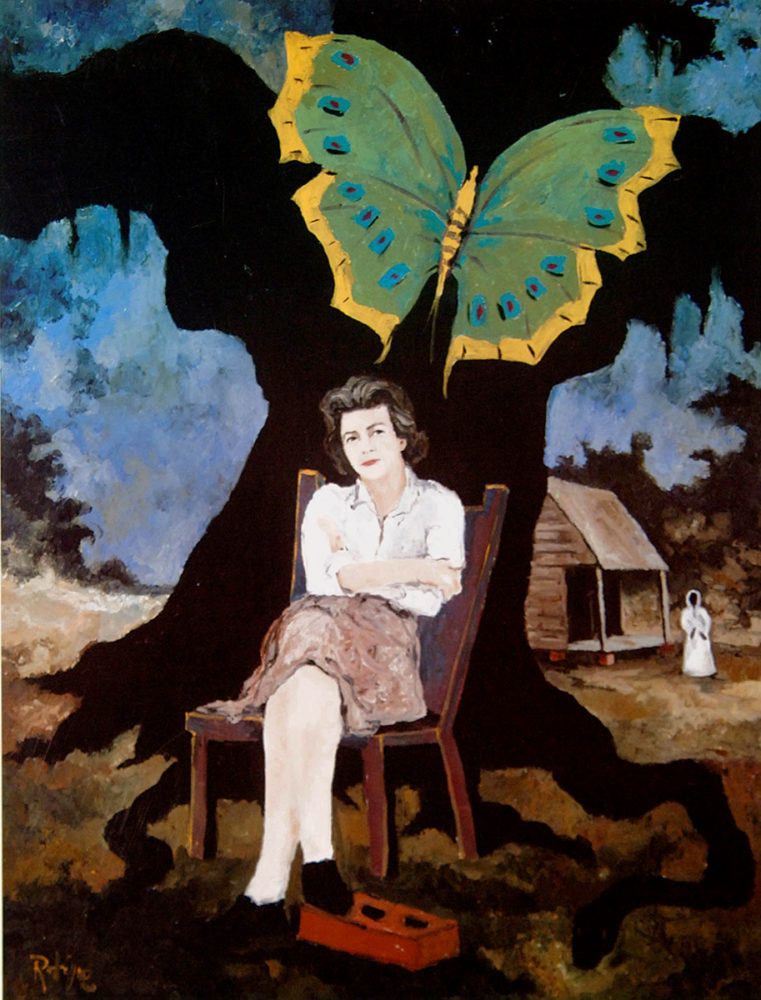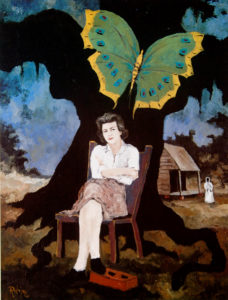Lost Lit
Sea Changes
Shirley Ann Grau’s debut novel evokes the coast
Published: December 1, 2019
Last Updated: March 2, 2020

George Rodrigue Foundation
Grau is among the many Louisiana legends immortalized by painter George Rodrigue.
How is it where you are? Are you okay? Can you find the supplies to cook what you love? Are there any oysters this season? Does Louisiana’s boot still have a sole? Is our state’s soul still intact?
Questions for a future catastrophe. Questions that are hardly new. Questions Shirley Ann Grau posed more than sixty years ago in her first novel, The Hard Blue Sky. A plotless narrative set during a long, hot summer on the fictional Isle aux Chiens, Grau spins a web of intensely intimate profiles of a Gulf island community. Their stories overlap, crashing into each other, like waves upon the shore.
There’s Julius Arcenaux, the grocer, who wages war with the wild packs of dogs that give the isle its name. His daughter Cecile is married to Hector Boudreau, who runs the Rendezvous, a marina and drinking spot for fishermen friends like Perique Lombas, the son of an eel farmer, and the Livaudais clan, roughneck men born and bred as “stubborn as crabs.” The Livaudais women tend to Mamere Terrebonne, a widow as ancient as the seas, who talks to loup-garous and braids shrimp tails into decorative wreaths.
As on any island, there are outsiders, those stranded, abandoned, and doomed to the life of martyrdom—characters like Inky D’Alfonso, a shipwrecked sailor; Adele, a recently widowed mother from nearby Port Ronquille who marries a local in order to survive; and Father Stanislaus Ryan, the whisky-sotted replacement for Father Gillespie, relieved of his priestly duties after going stir crazy and attacking imaginary cats with oyster shells.
At the center of this circle is sixteen-year-old Annie Landry, the island’s only blonde, a stranger at home who longs to escape to New Orleans. Her longing is lashed to adolescent ennui, to better opportunities ashore, to the fact that her island may have no future at all.
“Don’t you ever get afraid that this whole island is going to slip right under the water?” Annie asks a friend. Similar thoughts drift like flotsam through everyone’s mind. “There wasn’t any height or real-looking substance” to the island, Inky worries. “The wind and the Gulf together could lift it right off and scatter it all up and down the coast in a million billion pieces.” There’s a hurricane once every seven years, the islanders say. And Isle aux Chiens is long past due.
Over her lengthy career—her first book, The Black Prince and Other Stories, appeared in 1955—Grau tackled troublesome topics long before other writers. Three years following the publication of The Hard Blue Sky in 1958 came Grau’s The House on Coliseum Street, one of the first works of American fiction to address the abortion debate. Her next novel, The Keepers of the House, the story of a biracial marriage, won her acclaim, including the 1965 Pulitzer Prize, as well as the ire of right-wing reactionaries, who burned a cross in the front yard of her home. Three Southern-set novels and three short-story collections followed. Born in New Orleans, raised in Alabama, and living much of her life in the same Metairie home—she made ninety years this July—Grau has persistently eschewed the titles Southern author and woman writer.
The Hard Blue Sky proved her to be a young writer keenly aware of the intimate and fragile connections that link humanity with its environment, perhaps the most troublesome topic of all. In the final chapters of the novel, as a flood of wind delivers that distinct hurricane smell upon the Isle aux Chiens, its residents batten down or bundle up their belongings and flee. They obsess over radio reports and take solace in too much beer. Some bore holes in the floors of their houses to keep them from being swept away by the imminent tide. Grau reminds us that here, where water is a career, a cure, and a curse, even the cats know how to swim.
As the novel concludes, the church’s hourly chimes transform into a constant knell signaling the approaching storm, a toll for Louisiana, its soul, and the good people who call it home.
Rien Fertel wishes that all storms could be as tranquil, pleasurable, and romantic as Hurricane Barry.
